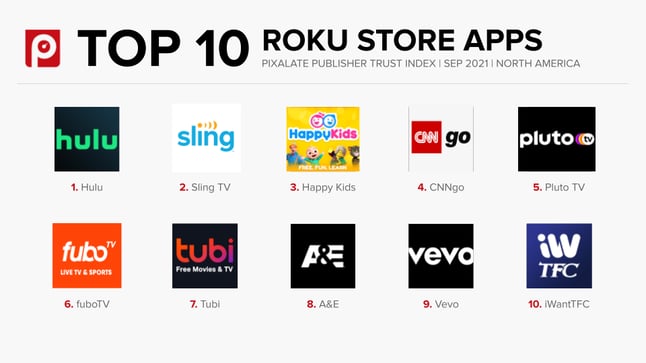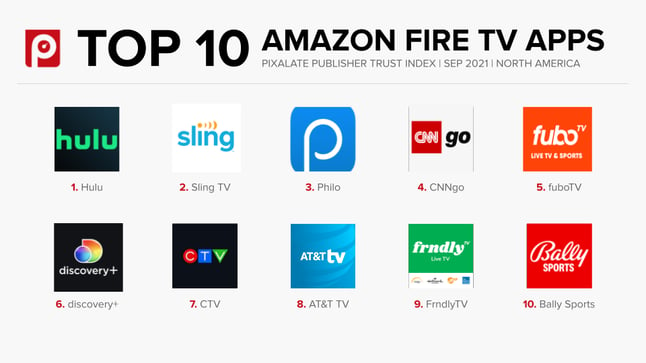


Hulu once again led the CTV Publisher Trust Indexes in North America, this time for the September 2021 rankings. Sling TV reached the No. 2 position in both the Roku and Amazon Fire TV indexes.
Hulu achieved both No. 1 positions by remarkable results across all measured metrics. The app obtained the highest possible score of 99 in the Ad Density and Popularity categories in both rankings. Moreover, with an estimated monthly reach of up to 22 million users, Hulu indicated lower overall potential for invalid traffic (IVT) advertising risks.
Sling TV also performed well across all measured metrics and was closely behind Hulu in both September CTV rankings. The app obtained the highest possible mark (“A”) across all categories, except for Engagement, in both classifications. Furthermore, Sling TV indicated low brand safety description risks across all measured categories.
There are more quality CTV apps for advertisers
fuboTV constantly appears in the top 10 of the CTV Publisher Trust Index, and September was not different. fuboTV obtained top 10 positions on both Roku and Amazon Fire TV rankings by excellent performance across all measured metrics, particularly Popularity and Engagement. The app also indicated a low advertising risk score in North America and globally.
Disclaimer
The content of this blog, and the Publisher Trust Indexes (collectively, the “Indexes”), reflect Pixalate’s opinions with respect to factors that Pixalate believes may be useful to the digital media industry. The Indexes examine programmatic advertising activity on mobile apps and Connected TV (CTV) apps (collectively, the “apps”). As cited in the Indexes and referenced in the Indexes’ key findings reproduced herein, the ratings and rankings in the Indexes are based on a number of metrics (e.g., “Brand Safety”) and Pixalate’s opinions regarding the relative performance of each app publisher with respect to the metrics. The data is derived from buy-side, predominantly open auction, programmatic advertising transactions, as measured by Pixalate. The Indexes examine global advertising activity across North America, EMEA, APAC, and LATAM, respectively, as well as programmatic advertising activity within discrete app categories. Any insights shared are grounded in Pixalate’s proprietary technology and analytics, which Pixalate is continuously evaluating and updating. Any references to outside sources in the Indexes and herein should not be construed as endorsements. Pixalate’s opinions are just that, opinions, which means that they are neither facts nor guarantees; and neither this press release nor the Indexes are intended to impugn the standing or reputation of any person, entity or app.
*By entering your email address and clicking Subscribe, you are agreeing to our Terms of Use and Privacy Policy.
These Stories on CTV
*By entering your email address and clicking Subscribe, you are agreeing to our Terms of Use and Privacy Policy.

Disclaimer: The content of this page reflects Pixalate’s opinions with respect to the factors that Pixalate believes can be useful to the digital media industry. Any proprietary data shared is grounded in Pixalate’s proprietary technology and analytics, which Pixalate is continuously evaluating and updating. Any references to outside sources should not be construed as endorsements. Pixalate’s opinions are just that - opinion, not facts or guarantees.
Per the MRC, “'Fraud' is not intended to represent fraud as defined in various laws, statutes and ordinances or as conventionally used in U.S. Court or other legal proceedings, but rather a custom definition strictly for advertising measurement purposes. Also per the MRC, “‘Invalid Traffic’ is defined generally as traffic that does not meet certain ad serving quality or completeness criteria, or otherwise does not represent legitimate ad traffic that should be included in measurement counts. Among the reasons why ad traffic may be deemed invalid is it is a result of non-human traffic (spiders, bots, etc.), or activity designed to produce fraudulent traffic.”

